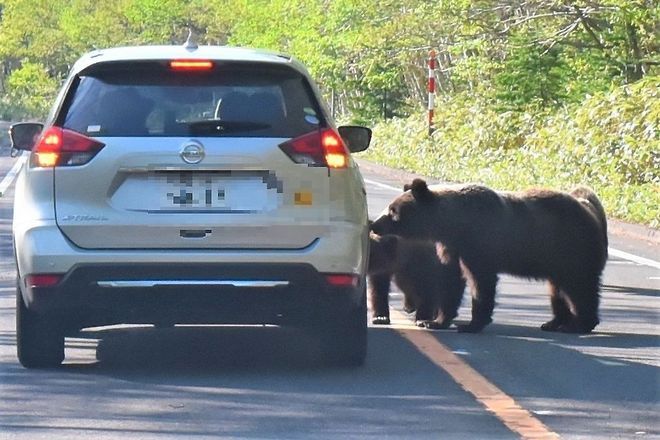Fisherman Motoharu Kase’s three children were playing in the garden of their home in Rausu, eastern Hokkaido, oblivious to the danger that lurked even though their pet dog, Koro, was tethered to a sandbag nearby.
Around 3 p.m. on that August day in 2019, the animal suddenly let out a hideous scream.
Realizing that something awful had happened, the family members mounted a search. They soon found tracks left by a brown bear leading into a patch of grass adjacent to the house.
A sandbag weighing more than 100 kilograms to which Koro’s leash was attached earlier had been moved.
They found the leash wrapped around a nearby tree at a height impossible for the dog to reach.
When Kenji Sakurai, 62, and other members of a local hunting association searched the area, they came across a brown bear feasting on Koro’s carcass.
It was the same bear blamed for killing or mauling eight pet dogs kept outdoors in Rausu on the Shiretoko Peninsula between 2018 and 2021. Locals had nicknamed the bear “Rusha Taro,” RT for short, after the Rusha district of nearby Shari, where the animal was first spotted.
It ate the dogs in most cases.
Because it marked the first time for “RT” to attack a dog in daylight hours, the incident sent shockwaves through the community.
Three years later, in July 2022, a male brown bear was captured in a box trap. It was later killed.
DNA samples taken from the animal were a match for RT.
UP CLOSE AND PERSONAL
The cases involving RT were just the tip of an iceberg of unconventional behavior displayed by brown bears in the scenic Shiretoko Peninsula over the past decade.
In July, the region marked the 20th anniversary of its listing as a UNESCO World Natural Heritage site, making the area a popular tourist destination.
Typical sightings include a brown bear gnawing on a car that had stopped on the Shiretoko Crossing Road one afternoon in May 2022.
The rental car was parked near the center line on a downhill section of the road in Shari which lies in the western part of the peninsula.
A mother and her two cubs were within 10 meters of the vehicle when they approached. The mother put her nose against the door on the driver’s side while one of the cubs reared up and shook its head repeatedly as it bit into a side mirror.
Between 400 and 500 brown bears inhabit the Shiretoko Peninsula, giving it one of the world’s highest concentrations of the animal.
There were at least 2,500 brown bear sightings in the region in 2023.
Traffic snarls known as “bear jams” that are caused by sightseers stopping their cars to look at brown bears are a common sight in Shiretoko from spring to autumn.
Some tourists and amateur photographers throw caution to the wind and approach the bears up close.
A revision to the Natural Parks Law that took effect in April 2022 makes it illegal to give brown bears food or venture too near.
Still, in fiscal 2024, there were a record 70 cases of dangerous and problematic behavior exhibited by people when brown bears were around.
Those on the front line working to prevent incidents involving bears and tourists tear their hair out over the fact patrol staff have no authority to deal with such problems. All they can do is warn that brown bears are in the vicinity.
“We face a situation where we have to be prepared in case residents and visitors in Shiretoko are attacked by brown bears,” said Tsuyoshi Ishinazaka, head of the Hokkaido Human-Wildlife Conflict Consultancy and Veterinary Clinic in Sapporo.
Ishinazaka worked for many years in Shiretoko devising ways to deal with brown bears and once served as head of the protection and management department at the Shiretoko Nature Foundation.
He speculated that dangerous bears share a trait: They have learned they can obtain food when humans are nearby.
Motorists who give food to bears that approach their vehicles are simply reinforcing that behavior, he said.
Hokkaido began an annual spring cull of brown bears in 1966. They are shot in Shiretoko and elsewhere across the northernmost main island by licensed hunters.
After the spring cull was abandoned in 1990, brown bears started showing up in complete disregard of any human nearby, having learned that people no longer pose a threat.
Miraculously, no resident or sightseer in Shiretoko has been attacked by a brown bear in nearly 40 years.
Bears that are judged to be problematic, like RT, are culled before they attack people, officials explained.
But there are limitations.
Ishinazaka pointed out that visitors often approach brown bears in Shiretoko even though they know it is illegal, knowing full well that no one has faced penalties because the law cannot be enforced.
“If this continues, there will be accidents involving tourists and residents,” he said. “We need a serious approach to implementing realistic laws and ordinances related to wildlife.”


AloJapan.com